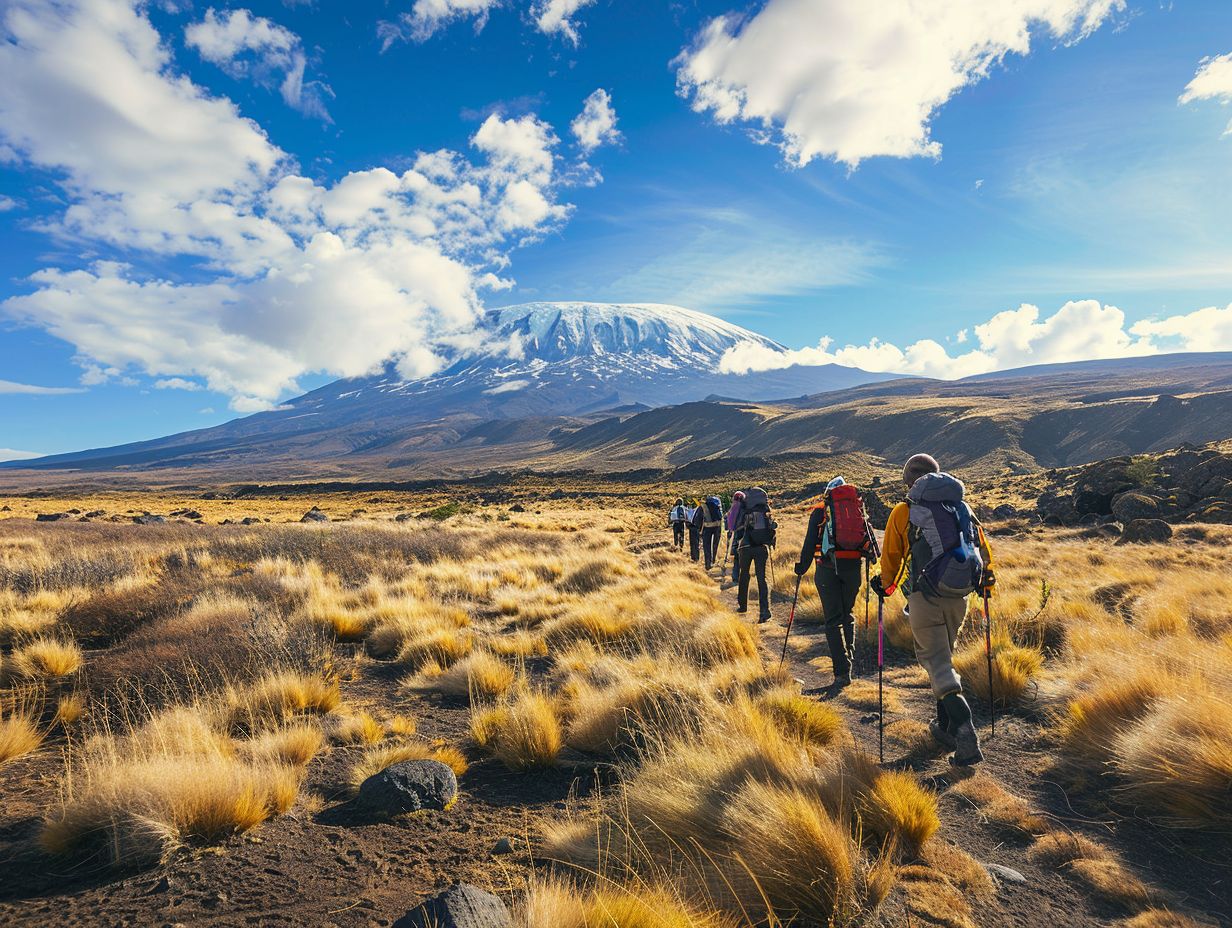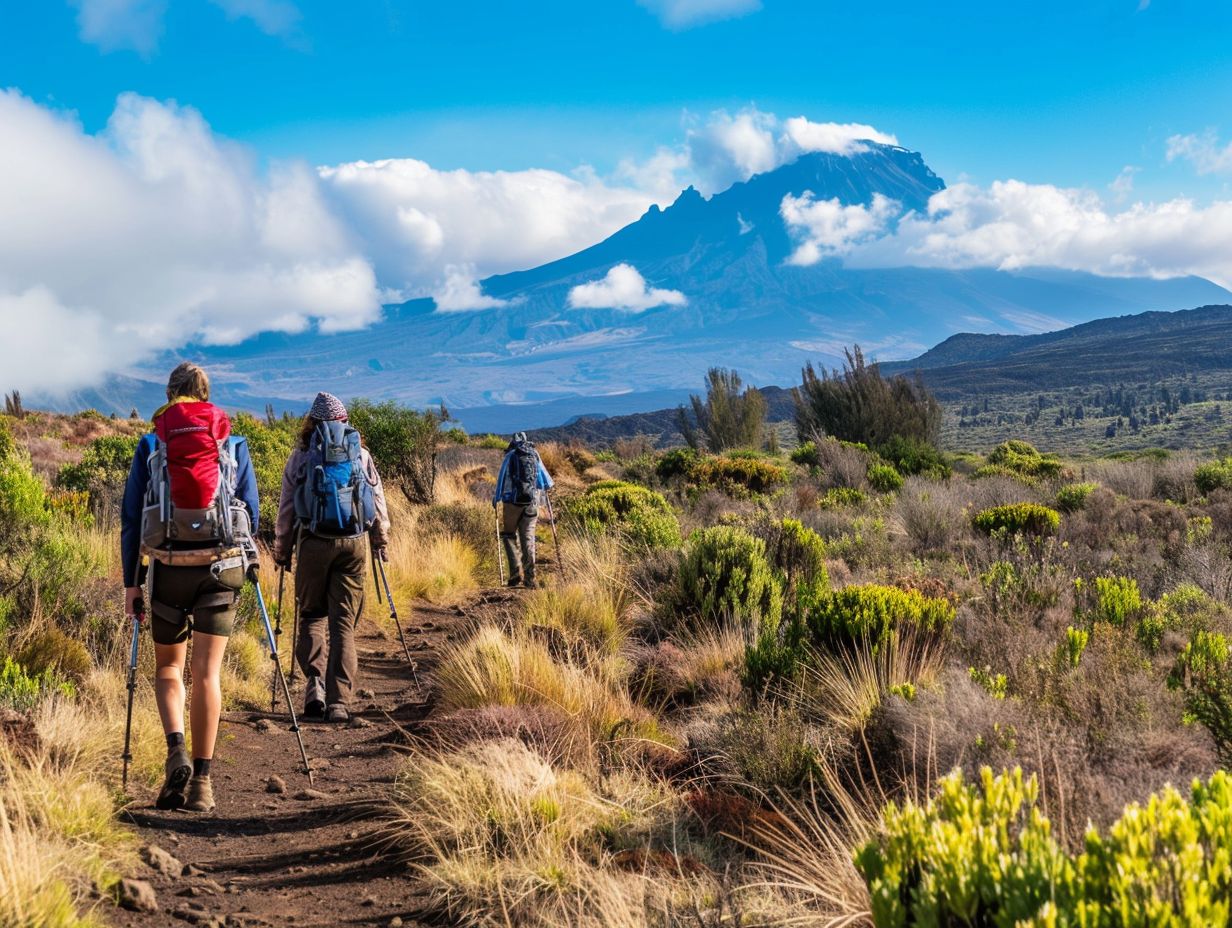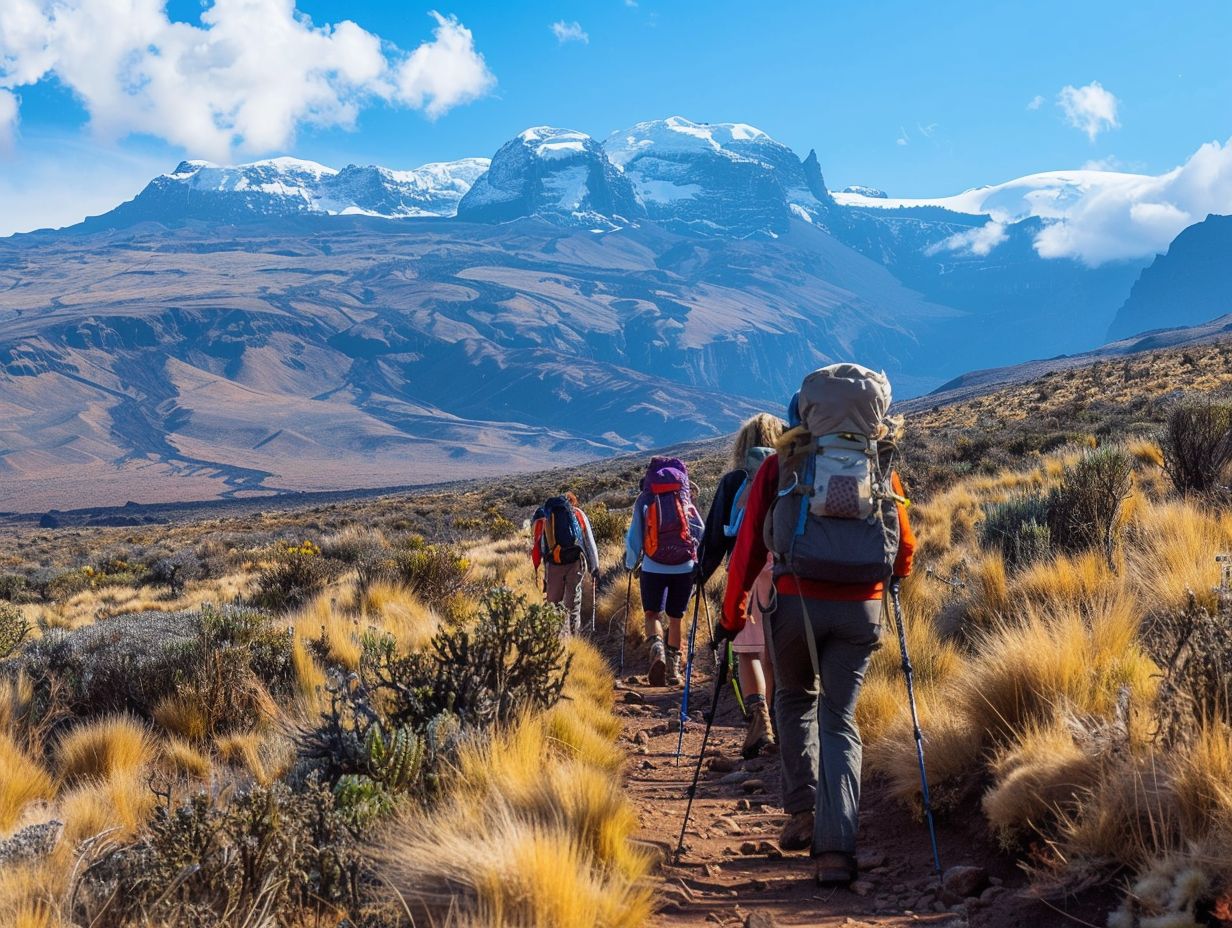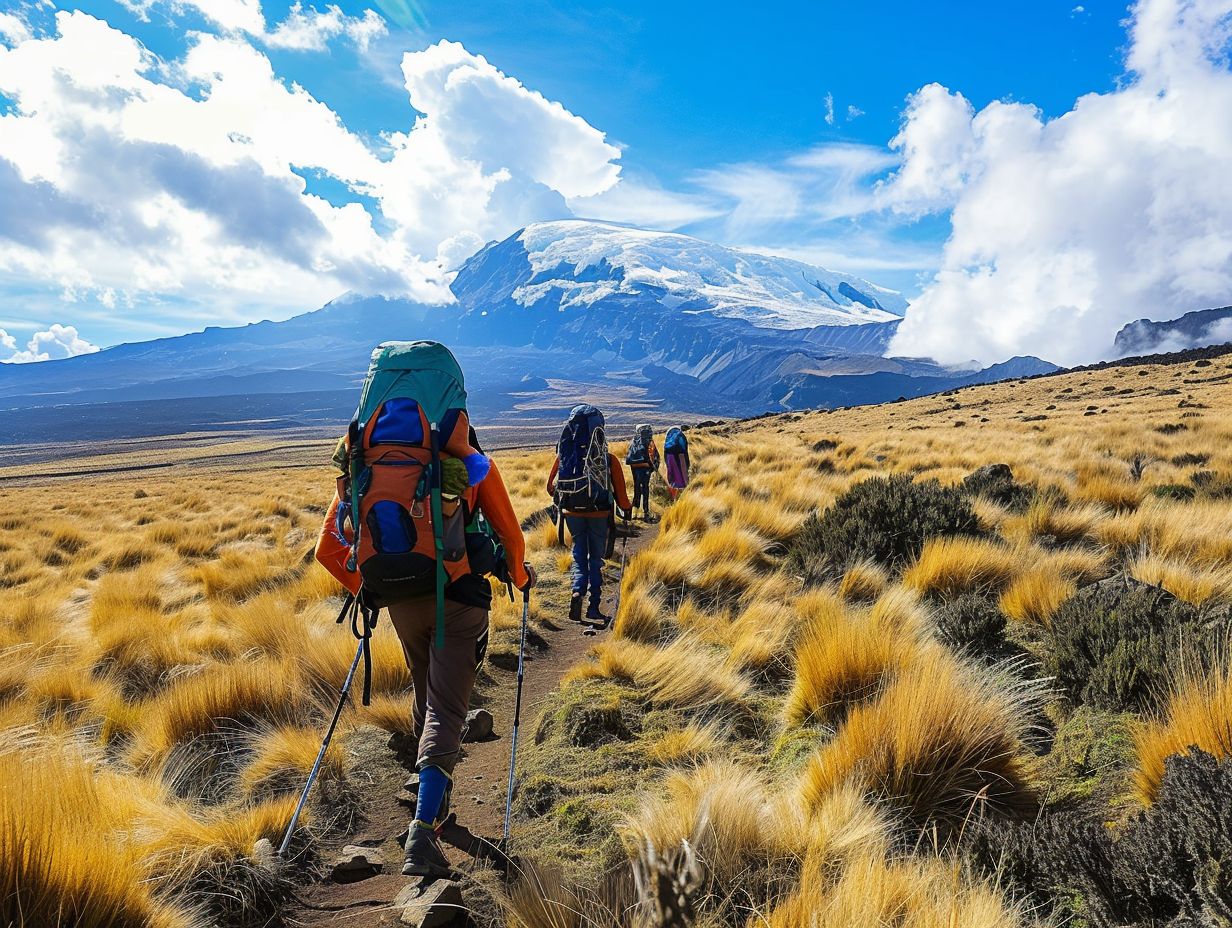
Looking to embark on a thrilling adventure to conquer Mount Kilimanjaro? The Northern Circuit Route might just be the perfect choice for you. This route offers a unique and less crowded experience compared to other popular routes. From the length of the trail to the difficulty level, best time to hike, itinerary, accommodation options, and highlights along the way, this guide covers everything you need to know before setting foot on this incredible journey. So, pack your bags and get ready for an unforgettable experience on the Northern Circuit Route!
Key Takeaways:

- The Northern Circuit Route offers a unique and less crowded experience compared to other routes on Kilimanjaro.
- The route is longer and considered to be challenging, making it ideal for experienced hikers looking for a more adventurous journey.
- The best time to hike the Northern Circuit Route is during the dry season from June to October, which offers clear skies and better chances of summiting.
Overview of the Northern Circuit Route
The Northern Circuit Route on Kilimanjaro is a challenging yet rewarding expedition that offers breathtaking views and diverse landscapes to climbers. This route stands out for its extended duration, providing ample time for acclimatization and increasing the chances of reaching the summit successfully.
The Northern Circuit Route spans approximately 57-70 miles (90-110 km), making it the longest route on Kilimanjaro, generally taking around 9-10 days to complete. Its varied terrain showcases the mountain’s diverse ecosystems, from lush rainforests to alpine deserts, offering trekkers a captivating journey through nature’s wonders.
This route is less crowded compared to other paths, allowing a more serene experience amidst the scenic beauty of the Tanzanian landscape. The unspoiled wilderness along the route adds to its allure, providing a sense of adventure and exclusivity to climbers.
What Makes the Northern Circuit Route Unique?
The uniqueness of the Northern Circuit Route lies in its extensive journey through varied ecosystems, starting from lush rainforests and ascending to alpine deserts, providing climbers with an unparalleled experience of diverse landscapes and flora along the way.
Ascending higher on the Northern Circuit Route, climbers encounter a remarkable shift in vegetation, transitioning from dense rainforests to an otherworldly alpine desert terrain. This change offers a visual spectacle as hikers navigate through the distinct environments, witnessing the adaptation of plants and wildlife to the harsher conditions at higher altitudes.
Acclimatization becomes crucial as climbers gain altitude, ensuring their bodies adjust to the reduced oxygen levels and challenging conditions for a greater chance of success. Despite the demanding nature of the route, proper acclimatization significantly improves the climbers’ overall success rate in reaching the summit.
How Long is the Northern Circuit Route?
The Northern Circuit Route spans approximately XX kilometers, offering climbers a longer journey compared to other routes on Kilimanjaro. The itinerary typically extends over YY days, allowing for gradual acclimatization and increased chances of summit success.
During this expedition, climbers traverse diverse landscapes, from lush rainforests to high-alpine deserts, experiencing the full spectrum of Kilimanjaro’s ecosystems. The longer duration of the Northern Circuit allows for a more relaxed pace, enabling climbers to properly adjust to the altitude and climate changes. As the route veers off the beaten path, trekkers can enjoy quieter trails and breathtaking views.
With ZZ campsites strategically positioned along the way, climbers have ample time to rest and rejuvenate after each day’s hike. These well-equipped campsites offer comfortable amenities, making the journey more manageable and enjoyable. The Northern Circuit Route truly offers a holistic Kilimanjaro experience, combining challenge with beauty and adventure.
What is the Difficulty Level of the Northern Circuit Route?
The Northern Circuit Route is considered a challenging climb due to its length, varying terrain, and high altitude conditions. Climbers face steep ascents, rocky paths, and changing weather conditions, making this route suitable for experienced trekkers seeking a demanding adventure.
One of the most strenuous features of the Northern Circuit Route is the constant elevation changes, which can take a toll on even the most physically fit individuals. The path is filled with uneven surfaces, loose rocks, and challenging obstacles that test climbers’ endurance and balance.
The unpredictable weather patterns on the mountain make planning difficult, with conditions shifting rapidly from scorching sun to freezing cold, adding an extra layer of challenge to the already demanding trek.
What is the Best Time to Hike the Northern Circuit Route?
The optimal time to hike the Northern Circuit Route is during the dry seasons in Tanzania, typically from X to Y months, when the weather is stable, and the trails are more accessible. This ensures a safer and more enjoyable climbing experience amidst the stunning landscapes of Kilimanjaro.
During these months, hikers can benefit from clear skies offering magnificent views of the surrounding scenery. The X to Y period also brings milder temperatures, creating comfortable conditions for trekking up the iconic Mount Kilimanjaro.
Trekking when the weather is favorable reduces the risk of encountering extreme weather conditions, improving safety on the challenging trails. The dry season enhances trail accessibility, making it easier to navigate through the diverse terrains of the Northern Circuit Route.
What is the Itinerary for the Northern Circuit Route?

The itinerary for the Northern Circuit Route includes various key points such as the beginning at Londorossi Gate, traversing through the picturesque Shira Plateau, reaching the iconic Uhuru Peak, and descending via the Mweka Route to Mweka Gate, offering a comprehensive exploration of Kilimanjaro’s diverse landscapes.
Starting the journey at Londorossi Gate, trekkers begin their adventure amidst the lush rainforests at around 2,100 meters above sea level, setting the tone for the days ahead. From there, the trail ascends through the Shira Plateau, offering breathtaking views of Mount Meru and the Great Rift Valley below.
As hikers progress, they eventually reach Uhuru Peak, the highest point of Kilimanjaro standing at 5,895 meters, providing a sense of accomplishment and awe-inspiring panoramic vistas.
The descent via the Mweka Route takes the trekkers through varied terrain, transitioning from the alpine desert to the lush rainforest once again, creating a full-circle experience of the mountain’s ecosystem. The journey comes to an end at Mweka Gate, marking the completion of this unforgettable expedition.
Day 1: Starting at Londorossi Gate
The journey on the Northern Circuit Route commences at Londorossi Gate, where climbers are greeted by the lush greenery of the rainforest, setting the tone for the adventure ahead amidst the diverse flora and fauna of Kilimanjaro.
As climbers pass through the Londorossi Gate, the air becomes noticeably cooler and filled with the earthy scents of the forest. The trail initially winds through dense vegetation, with towering trees providing shelter from the sun and creating a serene atmosphere for the first leg of the trek.
Stepping on the rich soil covered with fallen leaves, trekkers are accompanied by the sounds of chirping birds and rustling leaves, enhancing the immersive experience of nature. The guide leads the group with expert knowledge of the area, pointing out unique plant species and occasional glimpses of wildlife hidden in the greenery.
Day 2: Hiking through Shira Plateau
Day 2 of the Northern Circuit Route involves traversing the stunning Shira Plateau, characterized by expansive views of the mountain and unique rock formations, providing climbers with a memorable trekking experience amidst the high-altitude plateau landscape of Kilimanjaro.
As climbers continue their journey through the Shira Plateau on the second day, they are greeted by a vast expanse of rugged terrain that showcases the raw beauty of Kilimanjaro’s volcanic origins. The panoramic views from the plateau offer a breathtaking glimpse of the surrounding landscape, with distant peaks piercing through the clouds.
The geological features of the plateau, including the distinctive lava formations and scattered boulders, tell the story of the mountain’s turbulent history, adding a layer of intrigue to the trekking experience. Camping on the plateau under the star-studded African sky creates a surreal ambiance, inviting climbers to immerse themselves in the tranquility of the high-altitude wilderness.
Day 3: Crossing the Lava Tower
On Day 3 of the Northern Circuit Route, climbers face the challenge of crossing the imposing Lava Tower, a volcanic rock formation that provides a unique trekking experience and panoramic views of Kilimanjaro’s rugged terrain, showcasing the raw beauty of the mountain landscape.
Ascending towards the Lava Tower, trekkers are surrounded by the remnants of ancient volcanic activity, with the tower itself standing as a testament to nature’s fiery past. The geological significance of this towering formation lies in its lava composition, a reminder of Kilimanjaro’s volcanic origins.
As climbers navigate the rocky path leading to the top, they are rewarded with spectacular vistas stretching across the vast expanse of the mountain, allowing them to marvel at the sheer magnitude of the landscape below. The contrast between the charred volcanic rock and the snow-capped peaks creates a mesmerizing panorama that encapsulates the diverse beauty of Kilimanjaro.
Day 4: Summiting Uhuru Peak
Day 4 marks the pinnacle of the Northern Circuit Route as climbers push towards the summit of Uhuru Peak, the highest point of Kilimanjaro, where success and achievement await amidst the glaciers and sweeping vistas of the African continent below.
The challenging ascent to Uhuru Peak on the fourth day is a test of endurance and determination. Climbers navigate through rocky terrain, battling altitude sickness and pushing their physical limits to reach the top. As they ascend, the air thins, and each step becomes more arduous, but the allure of standing atop Kilimanjaro’s iconic peak drives them forward.
Reaching Uhuru Peak is a momentous achievement, symbolizing perseverance and triumph over the mountain. From the summit, climbers are rewarded with a breathtaking panorama that stretches as far as the eye can see, with majestic views of glaciers glistening in the sunlight and the vast expanse of the African plains below.
Day 5: Descending through Mweka Route
The final day of the Northern Circuit Route involves a descent through the scenic Mweka Route, where climbers reflect on their journey, descend through lush forests, and savor the accomplishment of conquering Kilimanjaro as they make their way to Mweka Gate.
As climbers begin their descent on the fifth day through the Mweka Route, their spirits are high from the successful summit experience. The transition from the challenging summit push to the serene descent allows them to truly appreciate the beauty of Kilimanjaro’s diverse landscapes.
Passing through verdant lush forests, the air is filled with the sweet scents of nature, providing a refreshing contrast to the icy summit. The campsite at Mweka Gate offers a place for rest and reflection, where climbers bask in the sense of achievement that comes with standing at the Roof of Africa.
What are the Accommodation Options on the Northern Circuit Route?

Accommodation on the Northern Circuit Route ranges from tented camps in the lower altitudes to high-altitude camps with basic facilities, providing climbers with a rustic yet immersive experience in the heart of Kilimanjaro’s diverse landscapes.
As trekkers ascend higher, they encounter camps strategically placed to acclimate them to the elevations, such as Horombo and Kibo Huts.
At these elevated camps, altitude sickness prevention is a primary concern, with experienced guides offering advice and assistance.
While the lower camps boast stunning views of the rainforest and moorlands, the higher camps are characterized by rocky terrain and panoramic vistas of glaciers.
What are the Highlights of the Northern Circuit Route?
The Northern Circuit Route offers a multitude of highlights, including diverse wildlife sightings, panoramic scenic views, and the advantage of less crowded trails, providing climbers with a unique and rewarding adventure through the untouched beauty of Kilimanjaro.
As climbers traverse through the Northern Circuit Route, they may be fortunate enough to spot majestic elephants, elusive leopards, and playful monkeys amidst the rich biodiversity that thrives in this region.
The experience is not just about conquering the summit but also about immersing oneself in the raw beauty of nature, with the rugged terrains leading to stunning vantage points where the vastness of Kilimanjaro unfolds before their eyes.
The tranquility of the less crowded paths allows for a more intimate connection with the surroundings, enhancing the sense of serenity and wonder that accompanies each step taken on this remarkable journey.
Wildlife Sightings
The Northern Circuit Route offers enchanting opportunities for wildlife sightings, with chances to spot indigenous species such as mountain antelopes, colobus monkeys, and a variety of bird species amidst the pristine habitats of Kilimanjaro’s diverse ecosystems.
As trekkers traverse through the montane forests of Kilimanjaro’s lower slopes, they may encounter the elusive elephants foraging quietly, buffalo herds grazing in the valleys, and perhaps even a glimpse of the elegant giraffes moving gracefully against the backdrop of looming peaks.
Higher up, the moorland zones reveal a tapestry of wildlife, with sightings of the remarkable elands, the acrobatic klipspringer leaping among rocks, and the melodious calls of sunbirds flitting around vibrant alpine flowers.
The alpine desert zone surprises with unique sightings of the tenacious rock hyraxes camouflaged among boulders, and the soaring flights of the mighty lammergeiers overhead, casting their shadows on the vast landscape.
Scenic Views
The Northern Circuit Route treats climbers to breathtaking scenic views of Kilimanjaro’s snow-capped peaks, rocky outcrops, and expansive plateaus, offering a visual feast of natural beauty that unfolds with each step of the trek across the diverse landscapes.
Ascending through the lush rainforests teeming with exotic flora and fauna, the trail gradually transitions into heath and alpine desert zones, each presenting a unique tableau of colors and textures.
As climbers navigate the challenging terrain, they are rewarded with sweeping vistas over endless savannah plains and shimmering glaciers, creating a mesmerizing contrast of environments. The rugged beauty of the cliffs and valleys, accompanied by the crisp mountain air, invigorates the spirit and heightens the sense of adventure on this remarkable journey.
Less Crowded
One of the notable advantages of the Northern Circuit Route is the relative solitude it offers, with fewer climbers compared to the more popular routes on Kilimanjaro, allowing trekkers to immerse themselves in the tranquility of nature and enjoy a more serene climbing experience.
The allure of the Northern Circuit Route lies in its less crowded trails, where you can escape from the hustle and bustle of everyday life and truly connect with the untamed beauty of the mountain. The peaceful ambiance envelops you as you trek through picturesque landscapes, offering a chance for introspection and rejuvenation amid the vast wilderness.
This intimate experience allows you to forge a deeper bond with the environment, listening to the rhythmic sounds of nature and feeling the crisp mountain air invigorate your senses. Unlike the busier paths, the Northern Circuit Route grants you the precious gift of solitude, where every step brings you closer to a tranquil state of mind, free from distractions.
What Should You Pack for the Northern Circuit Route?
Packing for the Northern Circuit Route requires careful consideration of essential items such as sturdy hiking boots, warm clothing layers, high-altitude gear, and adequate supplies for camping, ensuring climbers are equipped for the varied terrain and changing conditions encountered during the expedition.
Aside from the basics, it’s essential to pack moisture-wicking base layers to regulate body temperature, insulating mid-layers for warmth, and a waterproof jacket and pants to shield against rain and wind. Don’t forget gloves, hats, and sunglasses to protect against harsh sun and cold temperatures.
Packing high-energy snacks like nuts and energy bars will keep you fueled during challenging hikes. Bring a reliable headlamp for navigating in the dark, and a hydration system to ensure you stay hydrated at altitude. Moleskin or blister pads can be a lifesaver for foot care. A warm sleeping bag and mattress are crucial for a comfortable night’s rest at camp.”
Frequently Asked Questions

What is the Northern Circuit Route on Kilimanjaro?
The Northern Circuit Route is a relatively new and less traveled route on Mount Kilimanjaro in Tanzania. It is the longest and most scenic route, taking around 9-10 days to complete.
How is the Northern Circuit Route different from other routes on Kilimanjaro?
The Northern Circuit Route offers a unique and less crowded experience compared to other routes on Kilimanjaro. It also has the highest success rate due to its longer duration, allowing for better acclimatization.
What are the highlights of the Northern Circuit Route?
The Northern Circuit Route offers stunning views of the northern slopes of Kilimanjaro, including the scenic Shira Plateau and Lemosho Glades. It also passes through all the climate zones of Kilimanjaro, from rainforest to alpine desert.
Is the Northern Circuit Route suitable for beginners?
The Northern Circuit Route is not recommended for beginners as it is a longer and more challenging route. Previous high-altitude trekking experience is recommended, and proper physical fitness is required.
What is the best time to trek the Northern Circuit Route on Kilimanjaro?
The best time to trek the Northern Circuit Route is during the dry season, from December to February and June to October. These months offer the best weather conditions and clear views of the mountain.
Are there any age restrictions for the Northern Circuit Route?
There is no strict age restriction for the Northern Circuit Route, but trekkers must be at least 12 years old to participate. It is also recommended for those over the age of 60 to consult with a doctor before attempting this route.